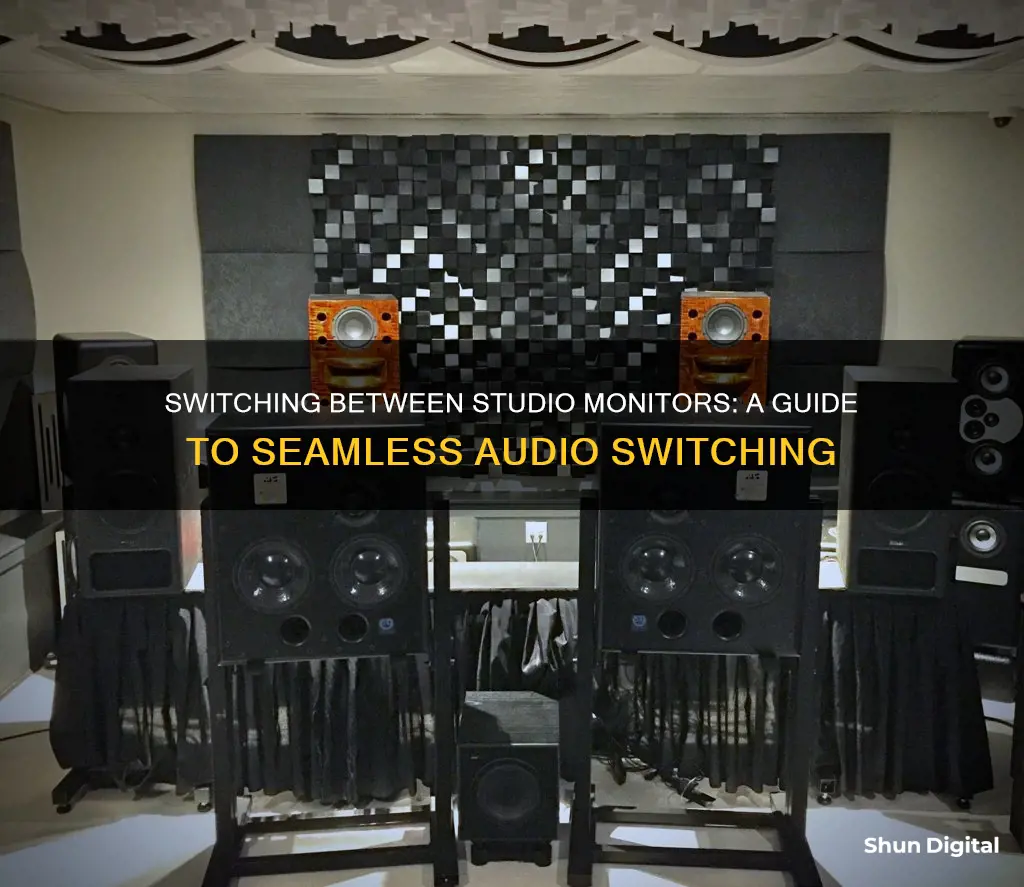
Studio monitors are an essential component of any recording setup, but what happens when you want to switch between your monitors and headphones? This is a common issue faced by singer-songwriters and audio engineers alike. The default option is to change the output settings in your DAW, but this can be a hassle, especially if you're looking for a quick way to compare your last take on different outputs. One solution is to invest in a monitor controller, which allows you to easily switch between outputs. Another option is to utilise your audio interface's capabilities, as most interfaces should allow you to monitor the main signal through both the headphone jack and the main outs simultaneously. This can be achieved with a simple setup in your DAW, creating two separate busses for your headphone output and main outs.
What You'll Learn

Using a monitor controller
To set up a monitor controller, you'll need to connect it to your audio interface, which should allow you to monitor the main signal from your DAW through both the headphone jack and the main outs (speakers) simultaneously. Most audio interfaces should support this, but if yours doesn't, a monitor controller can be a worthwhile investment.
When choosing a monitor controller, you'll find a variety of options available, including digital and analog systems. If you work primarily within a DAW, a digital system that integrates seamlessly with your software may be the best choice. On the other hand, if you prefer analog workflows, you can opt for a fully analog switching and routing unit or a digitally controlled analog system for added flexibility.
Some popular monitor controllers on the market include the Grace Design m905, the Dangerous Music MONITOR ST, and the PreSonus Monitor Station V2. These units offer features such as input and output routing, multiple headphone outputs with individual level controls, and talkback functionality. Additionally, the Heritage Audio Baby RAM 2-channel Monitoring System and the Audient Nero Desktop Monitor Controller provide Bluetooth connectivity, adding wireless convenience to your setup.
By incorporating a monitor controller into your studio, you'll be able to streamline your workflow, enhance your creativity, and focus on perfecting your mixes without the hassle of constant manual switching.
Troubleshooting an ASUS monitor: Power issues and solutions
You may want to see also

Stereo image widths
Stereo imaging is the process of positioning sounds within the stereo field to create the perception of locality. A good stereo image will help your mix sound wider and will give each instrument its own space in the mix.
The stereo image has three dimensions: height, width, and depth.
- Height is achieved with the proper use of levels and EQs.
- Width is achieved through panning, allowing sounds to move from one side of the mix to the other.
- Depth is created using time-based effects like reverb and delay to create a deep or shallow image.
When dealing with digital audio, we usually work with stereo files that contain a left and a right channel. Our playback source splits that and sends each signal to the corresponding output.
Tips for Achieving a Wide Mix
- Panning is the most crucial step for achieving a wide stereo image. Panning lets you place individual instruments or frequencies in a particular spot within your stereo image.
- Start your mix in mono to address any frequency balance issues that may cause listening fatigue.
- EQ your "presence zone" (2.5-5 kHz) to ensure that the lead vocals or other important elements stand out.
- Use reverb to add width and depth to your mix, creating a sense of spaciousness.
- Double tracking is a technique where you take two similar but slightly different recordings, place them on separate tracks, and pan them hard left and right to thicken the sound and make the mix sound larger and more expansive.
- Microshifting is another technique to create a wider stereo image. Duplicate a stereo track, pan it centre, then duplicate it twice more and patch a pitch-shifting plugin onto both copies, pitching one down and the other up by 5-10 cents, then pan one hard left and the other hard right.
- Use the Haas Effect to create width without changing the timbral qualities of your audio signal. This involves panning the dry sound to one side and adding a slightly delayed version of the sound (0-30 millisecond range) to the other side.
Other Considerations
- When mixing, it's important to consider the genre and instrumentation of the song. For example, in electronic music played in clubs, having a good mono mix is more important than stereo as clubgoers will only hear the sound from one speaker at a time.
- While it was once common to keep bass mono, especially when pressing music to vinyl, it is now possible to accurately replicate stereo bass on most playback systems, so it can be a creative decision to have stereo bass.
- When placing speakers, ideally, your listening position and the two monitors should form an equilateral triangle, with the monitors pointing directly at (or slightly behind) your head.
How Monitors Affect Chromebook Performance and Speed
You may want to see also

Speaker placement
The placement of your studio monitors is critical to achieving the best sound quality and accuracy. Here are some guidelines to help you optimise their placement:
Form an Equilateral Triangle
Arrange your listening position and the two monitors to form an equilateral triangle. Ideally, the distance between the left and right speakers and the distance from each speaker to the back of your head should be equal. This setup ensures a natural stereo "sweet spot", allowing you to move around slightly without compromising the sound quality.
Speaker Height and Angle
Adjust the height of your speakers so that the tweeters are at ear level when you are seated. Typically, this would be around 47-55 inches (120-140 cm) from the floor. Ensure that the monitors are angled slightly towards your head, as studio monitors sound their best when listened to on-axis. This will also help you hear high frequencies accurately.
Symmetry is Key
Place your speakers symmetrically in the room, maintaining the same distance to the nearest sidewall and the wall behind the monitor. This helps achieve the most accurate stereo imaging by ensuring similar reflections for the left and right monitors.
Avoid Reflections from Nearby Hard Surfaces
Acoustically hard surfaces like windows, drywall, mirrors, and non-absorptive materials can cause comb filtering, altering the sound you hear. Use a flat mirror to detect these reflections, and if you see the speaker's reflection, apply absorption to that surface.
Distance from Walls
The distance between your monitors and the walls can significantly impact sound quality. Try to place your monitors either very close to the front wall or at least 43 inches (110 cm) away to avoid exaggerated bass response and speaker-boundary interference. If your speakers have a rear port, maintain a distance of at least 5-10 cm from the wall.
Adjust and Fine-Tune
Finally, fine-tune the placement and settings of your monitors. Listen to familiar music that you know sounds great on various systems, and adjust your monitors until they reproduce that sound accurately. If there is too much bass, move the speakers away from walls and corners, and adjust the EQ settings if available.
How Monitors Affect Your Performance and Productivity
You may want to see also

Head positioning
Form an Equilateral Triangle: Your head should form an equilateral triangle with your monitors. This means that the distance between the left and right speakers and the distance from each speaker to the back of your head should be equal. This setup ensures a natural stereo "sweet spot", allowing you to move around slightly without compromising the sound quality.
Center Your Chair: Place your chair in the centre between the side walls to maintain a symmetrical stereo image. This helps to minimise any discrepancies in sound between the left and right speakers.
Avoid Halfway Points: Set the chair height so that your head is not positioned halfway between the ceiling and floor. Similarly, adjust the chair/desk position so that it is not halfway between the front and back walls. These measures help to reduce the impact of room modes, which can cause issues with sound balance.
Measure and Compare Distances: Use a tape measure to ensure that the distances between your head and the side walls, front and back walls, and ceiling are neither the same nor exact multiples of each other. This helps to minimise the formation of standing waves, which can distort the sound.
Initial Reflection Points: Familiarise yourself with the initial reflection points in your setup. These are the spots on the walls and ceiling where you would see the reflections of your monitors if they were mirrors. Cover these points with acoustic panels to reduce sound reflections.
Add Diffusion to the Rear Wall: The wall behind your head should be covered in diffusers to scatter the sound energy and prevent the creation of standing waves. This is especially important as a large portion of the sound energy from the monitors is directed towards you and the wall behind.
Removing Ghost Monitors: A Step-by-Step Guide to Success
You may want to see also

Acoustic treatment
There are several common acoustic problems that can arise in any room: comb filtering, flutter echo, room modes, and excessive decay time. These issues are caused by the way sound interacts with the space you're in and can be mitigated through careful acoustic treatment.
- Optimise the listening position: Before applying acoustic treatment, optimise the listening position in your room. This will help minimise acoustic problems and make the treatment more effective, cheaper, and easier to apply.
- Absorption: Use absorptive materials to reduce the energy of sound waves. Dense, porous materials are ideal for this purpose, as sound enters through the pores, gets trapped, and is converted into heat. Focus on treating the ceiling above your desk, the walls to the sides, the corners of the room, and the back wall.
- Reflection/Diffusion: While too much reflection can cause issues, some reflection is necessary to create a natural-sounding space. Use reflective materials to redirect sound energy and create a sense of space. This can be particularly useful for dealing with flutter echo and standing waves.
- Decoupling and Coupling: Decouple your speakers from the floor to prevent vibrations from the enclosure affecting playback accuracy. For wooden floors, use damping pads or feet to reduce the amplitude of vibrations. For dense concrete floors, coupling with speaker spikes can help dissipate vibrations effectively.
- Bass Traps: Place bass traps in the corners of the room to absorb low-end energy and prevent bass buildup.
- Hybrid Treatment: In some cases, a combination of absorption and reflection may be beneficial. For example, if your studio still sounds too lively with reflectors/diffusors, try installing hybrid diffusor/absorber panels.
- Software Refinement: Once you've applied acoustic treatment, use software like Room EQ Wizard (REW) to refine your setup and optimise your studio's acoustics. This software can help predict ideal locations for acoustic treatment and provide visual feedback on your room's frequency response.
- Avoid Common Myths: Stay away from ineffective acoustic treatment options like thin black foam panels, egg cartons, and thin moving blankets. These are typically inadequate for mid to low-end frequency absorption.
By following these steps and tailoring them to your unique studio space, you can create an accurate and trustworthy listening environment for your studio monitors.
Calibrating Your ASUS Monitor: Perfect Color Display
You may want to see also
Frequently asked questions
You can use a monitor controller or set up a template session in your DAWequilateral triangle with your head, with the monitors pointing directly towards your head. The distance between the left and right speakers and the distance from each speaker to the back of your head should be equal.
The tweeters of your studio monitors should be at head height (ear level) so that your ears are directly in front of the speakers.
Some common mistakes to avoid when placing your studio monitors include not achieving symmetry in the room, placing the monitors too close to reflective surfaces, and not adjusting the monitors to sound correct.
To minimize the impact of room acoustics, try to create an environment with a natural balance of sounds. Position your monitors against the longest wall, vary the distances between the monitors and each wall, and add acoustic treatment such as bass traps and absorption panels.







